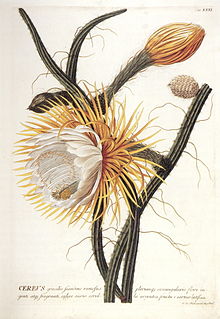You are here
Magnoliopsida
Selenicereus (A. Berger) Britton & Rose
EOL Text
Selenicereus
Lianas o arbustos rastreros, que trepan mediante raíces adventicias. Tallos verdes, alargados, con 4-12 ángulos o costillas. Hojas ausentes; areolas diminutas, usualmente formando un pequeño promontorio, densamente cubiertas por pelos lanosos y espinas aciculares. Flores actinomorfas, bisexuales, nocturnas, solitarias; perianto alargado, infundibuliforme; tépalos externos escamiformes, con areolas densamente cubiertas por pelos largos, lanosos; tépalos internos petalíferos; estambres numerosos, insertos en el perianto; ovario ínfero, el estilo grueso, los estigmas numerosos; ovario ínfero. Fruto una baya grande, rojiza, cubierta por brácteas basales y algunas espinas; semillas numerosas, diminutas. Género caribeño con alrededor de 16 especies.
Selenicereus
Lianas or creeping shrubs, which climb by adventitious roots. Stems green, elongate, with 4-12 angles or ribs. Leaves absent; areoles minute, usually forming a small promontory, densely covered with lanate hairs and acicular spines. Flowers actinomorphic, bisexual, nocturnal, solitary; perianth elongate, infundibuliform; outer tepals scale-like, with areoles densely covered with long, lanate hairs; inner tepals petaliferous; stamens numerous, inserted on the perianth; ovary inferior, the style thick, the stigmas numerous; ovary inferior. Fruit a large, reddish berry, covered by basal bracts and several spines; seeds numerous, minute. A Caribbean genus of about 16 species.
Barcode of Life Data Systems (BOLD) Stats
Specimen Records:83
Specimens with Sequences:83
Specimens with Barcodes:12
Species:16
Species With Barcodes:16
Public Records:81
Public Species:15
Public BINs:0
Moonlight cacti, genus Selenicereus, is an epiphytic, lithophytic, and terrestrial cactus genus found in Central America, the Caribbean and northern South America.
Contents |
Description
Clambering plants with flat to angled stems, producing aerial roots. Areoles may be with or without spines. Flowers are large and nocturnal, pollinated by moths or rarely bats. The receptacle bears small bracts, hairs and usually spines. Fruits bear numerous spines. Flowers are generally produced in abundance with mature plants and are typically white and are very fragrant and only last a single night in most species.
Etymology
The generic name is derived from Σελήνη (Selene), the Greek moon goddess, and cereus, meaning "candle" in Latin, referring to the nocturnal flowers. The term nightblooming cereus is sometimes used here, but this is also used for many night blooming cacti, including Epiphyllum, Hylocereus and Peniocereus.
Species
| Species | Description | Image |
|---|---|---|
| Selenicereus anthonyanus (Alexander) D.R.Hunt |
Mexico. Stems like those of Epiphyllum anguliger but more vining and with short spines. Flowers ca. 12 cm long, 10–15 cm wide, the outer inner tepals purplish, the inner cream. |  |
| Selenicereus atropilosus | Mexico. Flowers 12 cm long, receptacle with black hairs. The species is close to some species in the genus Weberocereus | |
| Selenicereus chrysocardium | Mexico. Stems deeply lobed, ca. 28 cm wide. Flowers 32–38 cm long, 23–30 cm wide, base of receptacle very spiny. The species is close to the genus Epiphyllum. | |
| Selenicereus grandiflorus (L.) Britton & Rose |
Jamaica, Cuba; Guatemala, Honduras, Nicaragua. Stems many-ribbed. Flowers 18 cm long, receptacle densely woolly. Three subspecies are recognized:
ssp. grandiflorus |
|
| The following species are very closely related to each other and possibly better treated as synonymous taxa or subspecies. | ||
| *Selenicereus boeckmannii | Cuba, Haiti, Dominican Republic, Mexico. Flowers 24–39 cm long. Close to S. pteranthus. | |
| *Selenicereus brevispinus | Cuba. Spines less and 1 mm long. Flowers 25 cm long. A shortspined S. grandiflorus. | |
| *Selenicereus coniflorus (Weing.) Britton & Rose |
Mexico. Stems thick, usually with 5-6 ribs, spines to 1,5 cm long. Flowers 22–25 cm long. A long spined S. pteranthus or few ribbed S. grandiflorus. | |
| *Selenicereus hallensis | Colombia? Only known in cultivation and possibly a hybrid with S. macdonaldiae and some other "species". | |
| *Selenicereus urbanianus | Cuba, Haiti, Dominican Republic. Stems 4-5-ribbed, flowers 20–30 cm long. | |
| Selenicereus hamatus (Scheidw.) Britton & Rose |
Mexico. Stems 3-4-ribbed, with knobby projections, nearly spineless. Flowers 20–25 cm long, receptacle with black hairs. | |
| Selenicereus inermis | Venezuela, Colombia. Stems 2-5-ribbed, almost spineless. Flower 15 cm long, spiny, hairless. The following species are probably best treated as synonymous or subspecies of S. inermis: | |
| *Selenicereus rubineus | Mexico. Stems 4-5-ribbed. Flowers 18 cm. wide, 18–19 cm long, inner and outer inner tepals flushed ruby-red near base. | |
| *Selenicereus wercklei | Costa Rica. Stem with 6-12 low ribs. Flower 15–16 cm long, spiny, hairless. | |
| Selenicereus murrillii | Mexico. Stems only 8 mm thick, nearly spineless. Flowers 15 cm long, spiny, hairless. Closely related to S. spinulous and S. inermis (sensu lat.). | |
| Selenicereus pteranthus (Link & Otto) Britton & Rose |
Two forms are recognized.
f. macdonaldiae - Honduras? Stem ribs tubercled. Flowers 30–34 cm long. |
|
| Selenicereus spinulosus (DC.) Britton & Rose |
Texas, Mexico. Stems short-spined. Flowers 8–14 cm long, receptacle spiny, hairless. | |
| Selenicereus vagans | Mexico. Flower 15 cm long, receptacle spiny, hairless. | |
| *Selenicereus nelsonii | Mexico. Flowers 20 cm long, receptacle hairless, spiny. Probably conspecific with S. vagans. | |
| Selenicereus validus | Michoacán, huge nocturnal flowers with bright red fruits. (Mesa Gardens 1244.5936) |
Formerly placed here
- Hylocereus megalanthus (K.Schum. ex Vaupel) Ralf Bauer (as S. megalanthus (K.Schum. ex Vaupel) Moran)
- Hylocereus setaceus (Salm-Dyck ex DC.) Ralf Bauer (as S. setaceus (Salm-Dyck ex DC.) Werderm.)[2]
References
| Wikimedia Commons has media related to: Selenicereus |
| Wikispecies has information related to: Selenicereus |
- ^ a b "Genus: Selenicereus (A. Berger) Britton & Rose". Germplasm Resources Information Network. United States Department of Agriculture. 2004-02-13. Retrieved 2011-04-14.
- ^ "GRIN Species Records of Selenicereus". Germplasm Resources Information Network. United States Department of Agriculture. Retrieved 2011-04-14.
| License | http://creativecommons.org/licenses/by-sa/3.0/ |
| Rights holder/Author | Wikipedia |
| Source | http://en.wikipedia.org/w/index.php?title=Moonlight_cactus&oldid=552399117 |





